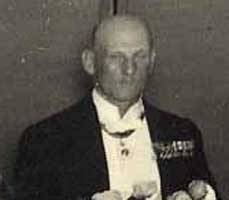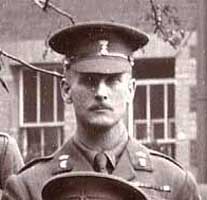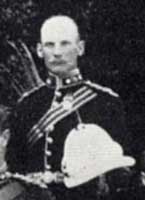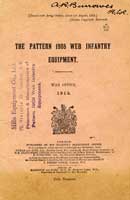Brig.-Gen. Arnold R. Burrowes, C.M.G., D.S.O.

 Arnold Robinson Burrowes was born 19th March, 1867, into a distinguished military family. His great-grandfather, Colonel Thomas Burrowes, was in the service of the Honourable East India Company, as well as M.P. for County Longford. His grandfather, Colonel Arnold Robinson Burrowes, born in 1788, fought in the Peninsular Wars between 1808 and 1814, as Aide-de-Camp to Field-Marshal Viscount Beresford. He gained the rank of Major in the service of the Scots Fusiliers Guards, and Colonel in the service of the Brantford Light Infantry.He emigrated to Canada arriving in 1834, where in 1837 he raised a regiment in the Mackenzie Rebellion. Gen. Burrowes' father, Arnold Burrowes, emigrated to England with his family in 1872.
Arnold Robinson Burrowes was born 19th March, 1867, into a distinguished military family. His great-grandfather, Colonel Thomas Burrowes, was in the service of the Honourable East India Company, as well as M.P. for County Longford. His grandfather, Colonel Arnold Robinson Burrowes, born in 1788, fought in the Peninsular Wars between 1808 and 1814, as Aide-de-Camp to Field-Marshal Viscount Beresford. He gained the rank of Major in the service of the Scots Fusiliers Guards, and Colonel in the service of the Brantford Light Infantry.He emigrated to Canada arriving in 1834, where in 1837 he raised a regiment in the Mackenzie Rebellion. Gen. Burrowes' father, Arnold Burrowes, emigrated to England with his family in 1872.
Brigadier-General Burrowes' own distinguished career is described in his obituary (see link at upper right), here reprinted from the pages of The Faugh-a-Ballagh, the Regimental Gazette of the 87th Royal Irish Fusiliers. He died on 9th February, 1949. The photograph at left was taken at a dinner at the Savoy Hotel in 1922.
 It's not just his long and illustrious military record, though, that has led Karkee Web to feature him here. In 1904, then-Capt. Burrowes (see photograph at right, taken in 1906) acquired Patent No. 14,059, Improvements in Cartridge Holders and in Equipments for use therewith (see the link below to view a complete copy of this patent). This patent described a novel form of infantry equipment, which was essentially a leather waistcoat for holding cartridges, coupled with a pair of braces supporting two haversacks carried on the back. Capt. Burrowes lobbied the War Office, trying to interest them in his equipment. At the same time, the Mills Woven Cartridge Belt Company of London, England, the predecessor company to the Mills Equipment Company, was knocking on the same doors in a very similar endeavour. In a spark of bureaucratic brilliance, someone there decided to put the two of them together. What happened next is described by Albert Lethern in the Mills Equipment Company's Golden Jubilee booklet, The Development of the Mills Woven Cartridge Belt 1877-1956:
It's not just his long and illustrious military record, though, that has led Karkee Web to feature him here. In 1904, then-Capt. Burrowes (see photograph at right, taken in 1906) acquired Patent No. 14,059, Improvements in Cartridge Holders and in Equipments for use therewith (see the link below to view a complete copy of this patent). This patent described a novel form of infantry equipment, which was essentially a leather waistcoat for holding cartridges, coupled with a pair of braces supporting two haversacks carried on the back. Capt. Burrowes lobbied the War Office, trying to interest them in his equipment. At the same time, the Mills Woven Cartridge Belt Company of London, England, the predecessor company to the Mills Equipment Company, was knocking on the same doors in a very similar endeavour. In a spark of bureaucratic brilliance, someone there decided to put the two of them together. What happened next is described by Albert Lethern in the Mills Equipment Company's Golden Jubilee booklet, The Development of the Mills Woven Cartridge Belt 1877-1956:
The writer of this narrative, who joined the Mills Woven Cartridge Belt Company as a junior in April, 1906, well remembers the preparations made at the office in readiness for the appointment which was accordingly arranged with Major Burrowes, and it can be said that in July, 1906, the fortunes of the Mills Company turned. Major Burrowes had patented a form of cartridge pockets arranged in two tiers at the back of which a strap was fitted diagonally, the idea being that any load supported by this strap on the back would transfer to the strain at the load to the front. ... The outcome of the collaboration with Major Burrowes resulted in an equipment being devised with a wide (3-in.) waist belt, two cartridge carriers of four pockets each (one pocket above three) for 60 rounds, each having the "Diagonal Strap" on the back, 2-in. braces crossing at the back and attached to the waist belt for supporting the Cartridge Carriers, a Pack having tabs at the top for attachment to movable buckles on the braces, and to complete the unique principle of balancing the pack load, two supporting straps were provided, which crossed over the outside of the pack and were connected to the diagonal straps on the back of the Cartridge Carriers, drawn tightly across the pack and fastened at the top.
 Two errors have crept into Mr. Lethern's narrative, one minor and one more significant. Both of them need to be mentioned, though, since they have both been accepted as fact and repeated time and again since the Mills Golden Jubilee booklet was published in 1956. First of all, Captain Burrowes obtained his majority only in November of 1906, so he was still a captain when he met and cooperated with the Mills Company. More importantly, a reading of Capt. Burrowes' patent will reveal that his design did not include "a strap was fitted diagonally, the idea being that any load supported by this strap on the back would transfer to the strain at the load to the front." In fact, Capt. Burrowes' design balanced the loads back and front by suspending parallel haversacks from the rear of each brace, offsetting the weight of the cartridge carriers at the front. The location where the photograph at left was taken is not clear. Although the resolution is too low to be sure, he could be a major in this picture. If so, the photo would date to between November, 1906 (when he completed his cooperative efforts with the Mills Company and was promoted, then posted to Bermuda), and 14th September, 1914 (the day after the battle of Le Cateau, when he was promoted to Lt. Colonel and assumed command of 1st Regiment, R.I.F.). Given the dress uniform he is wearing, Bermuda (where he served 1906 - 1911) seems a likely choice.
Two errors have crept into Mr. Lethern's narrative, one minor and one more significant. Both of them need to be mentioned, though, since they have both been accepted as fact and repeated time and again since the Mills Golden Jubilee booklet was published in 1956. First of all, Captain Burrowes obtained his majority only in November of 1906, so he was still a captain when he met and cooperated with the Mills Company. More importantly, a reading of Capt. Burrowes' patent will reveal that his design did not include "a strap was fitted diagonally, the idea being that any load supported by this strap on the back would transfer to the strain at the load to the front." In fact, Capt. Burrowes' design balanced the loads back and front by suspending parallel haversacks from the rear of each brace, offsetting the weight of the cartridge carriers at the front. The location where the photograph at left was taken is not clear. Although the resolution is too low to be sure, he could be a major in this picture. If so, the photo would date to between November, 1906 (when he completed his cooperative efforts with the Mills Company and was promoted, then posted to Bermuda), and 14th September, 1914 (the day after the battle of Le Cateau, when he was promoted to Lt. Colonel and assumed command of 1st Regiment, R.I.F.). Given the dress uniform he is wearing, Bermuda (where he served 1906 - 1911) seems a likely choice.
 Regardless of exactly who provided which design features, there can be no doubt that collaboration was a rousing success. The resultant design was called the Mills-Burrowes Web Infantry Equipment, and was patented by the newly formed Mills Equipment Company as No. 28,812, Improvements in or relating to Military Equipments and the like, with an approval dated of 8th August 1907. As with Capt. Burrowes' original patent, the full patent is available at the link below. The Army Council accepted the design as its new standard for infantry equipment in December, 1907, and Web Equipment, Pattern 1908, as it was now officially known, was accepted by the King on 30th January 1908. The picture at right is a scan of the cover of Brig.-Gen. Burrowes' personal copy of the 1913 fitting instruction manual for Patt. '08, entitled The Pattern 1908 Web Infantry Equipment.
Regardless of exactly who provided which design features, there can be no doubt that collaboration was a rousing success. The resultant design was called the Mills-Burrowes Web Infantry Equipment, and was patented by the newly formed Mills Equipment Company as No. 28,812, Improvements in or relating to Military Equipments and the like, with an approval dated of 8th August 1907. As with Capt. Burrowes' original patent, the full patent is available at the link below. The Army Council accepted the design as its new standard for infantry equipment in December, 1907, and Web Equipment, Pattern 1908, as it was now officially known, was accepted by the King on 30th January 1908. The picture at right is a scan of the cover of Brig.-Gen. Burrowes' personal copy of the 1913 fitting instruction manual for Patt. '08, entitled The Pattern 1908 Web Infantry Equipment.
It is no exaggeration to state that W.E. Patt. '08 was the single most important development in the history of military load bearing equipment. With it, the British Tommy entered the Great War as the best accoutred of any soldier in the conflict, and just about every major design of personal equipment of the 20th Century derived from it or its Mills Equipment Company successors. Captain Burrowes could hardly have guessed just how important his 1904 design would eventually prove to be.
Patents: These are presented as PDF files. You'll need to use your browser's back button to return to Karkee Web after viewing them.
Patent No. 14,059 Improvements in Cartridge Holders and in Equipments for use therewith, Approval dated 23rd June 1904
Captain Burrowes' original patent for his equipment.
Patent No. 28,812 Improvements in or relating to Military Equipments and the like, Approval dated 8th August 1907
The Mills Equipment Company's original patent for what would become Web Equipment, Pattern 1908.
U.S. Patent No. 874,945 Military Equipment, Approval dated 31st. December 1907
For completion's sake, I've added the U.S. version of the Mills-Burrowes patent. The text differs only slightly from the British original, but the drawings are distinctly different and informative.
A VERY SPECIAL NOTE OF APPRECIATION:
This article would not have been possible without the assistance and cooperation of the Royal Irish Fusiliers Museum, Sovereign's House, The Mall, Armagh. Special thanks goes to Jonathan Maguire, Researcher, Royal Irish Fusiliers Museum, who located the photographs of Capt., Major (?), and Gen. Burrowes, his obituary, and his copy of the 1913 manual in the museum archives; and to Amanda Moreno, Curator, Royal Irish Fusiliers Museum, for permission to reproduce the museum's archive material.